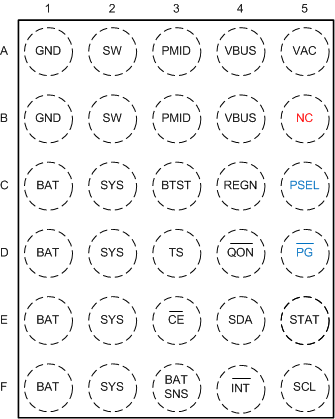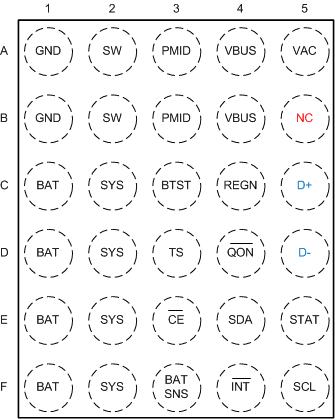SLUSCJ4B June 2017 – March 2022 BQ25600 , BQ25600D
PRODUCTION DATA
- 1 Features
- 2 Applications
- 3 Description
- 4 Revision History
- 5 Description (continued)
- 6 Pin Configuration and Functions
- 7 Specifications
-
8 Detailed Description
- 8.1 Overview
- 8.2 Functional Block Diagram
- 8.3
Feature Description
- 8.3.1 Power-On-Reset (POR)
- 8.3.2 Device Power Up from Battery without Input Source
- 8.3.3 Power Up from Input Source
- 8.3.4 Boost Mode Operation From Battery
- 8.3.5 Host Mode and Standalone Power Management
- 8.3.6 Power Path Management
- 8.3.7 Battery Charging Management
- 8.3.8 Protections
- 8.4 Device Functional Modes
- 8.5 Programming
- 8.6 Register Maps
- 9 Application and Implementation
- 10Power Supply Recommendations
- 11Layout
- 12Device and Documentation Support
- 13Mechanical, Packaging, and Orderable Information
Package Options
Mechanical Data (Package|Pins)
- YFF|30
Thermal pad, mechanical data (Package|Pins)
Orderable Information
6 Pin Configuration and Functions
 Figure 6-1 BQ25600 YFF Package30-Pin WCSPTop View
Figure 6-1 BQ25600 YFF Package30-Pin WCSPTop View Figure 6-2 BQ25600D YFF Package30-Pin WCSPTop View
Figure 6-2 BQ25600D YFF Package30-Pin WCSPTop ViewTable 6-1 Pin Functions
| PIN | TYPE(1) | DESCRIPTION | ||
|---|---|---|---|---|
| NAME | BQ25600 | BQ25600D | ||
| WCSP | WCSP | |||
| BAT | C1 | C1 | P | Battery connection point to the positive terminal of the battery pack. The internal current sensing resistor is connected between SYS and BAT. Connect a 10 µF closely to the BAT pin. |
| D1 | D1 | |||
| E1 | E1 | |||
| F1 | F1 | |||
| BATSNS | F3 | F3 | AIO | Battery voltage sensing pin for charge current regulation. in order to minimize the parasitic trace resistance during charging, BATSNS pin is connected to the actual battery pack as close as possible. |
| BTST | C3 | C3 | P | PWM high side driver positive supply. internally, the BTST is connected to the cathode of the boost-strap diode. Connect the 0.047-μF bootstrap capacitor from SW to BTST. |
| CE | E3 | E3 | DI | Charge enable pin. When this pin is driven low, battery charging is enabled. |
| D+ | — | C5 | AIO | Positive line of the USB data line pair. D+/D– based USB host/charging port detection. The detection includes data contact detection (DCD), primary and secondary detection in BC1.2. |
| D– | — | D5 | AIO | Negative line of the USB data line pair. D+/D– based USB host/charging port detection. The detection includes data contact detection (DCD), primary and secondary detection in BC1.2. |
| GND | A1 | A1 | P | Ground |
| B1 | B1 | |||
| INT | F4 | F4 | DO | Open-drain interrupt Output. Connect the INT to a logic rail through 10-kΩ resistor. The INT pin sends active low, 256-µs pulse to host to report charger device status and fault. |
| NC | B5 | B5 | No connection. This pin must be floating. | |
| PG | D5 | — | DO | Open drain active low power good indicator. Connect to the pull up rail through 10 kΩ resistor. LOW indicates a good input source if the input voltage is between UVLO and ACOV, above SLEEP mode threshold, and current limit is above 30 mA. |
| PMID | A3 | A3 | DO | Connected to the drain of the reverse blocking MOSFET (RBFET) and the drain of HSFET. Given the total input capacitance, put 1 μF on VBUS to GND, and the rest capacitance on PMID to GND. |
| B3 | B3 | |||
| PSEL | C5 | — | DI | Power source selection input. High indicates 500 mA input current limit. Low indicates 2.4A input current limit. Once the device gets into host mode, the host can program different input current limit to IINDPM register. |
| QON | D4 | D4 | DI | BATFET enable/reset control input. When BATFET is in ship mode, a logic low of tSHIPMODE duration turns on BATFET to exit shipping mode. When VBUS is not plugged–in, a logic low of tQON_RST (minimum 8 s) duration resets SYS (system power) by turning BATFET off for tBATFET_RST (minimum 250 ms) and then re-enable BATFET to provide full system power reset. The pin contains an internal pull-up to maintain default high logic. |
| REGN | C4 | C4 | P | PWM low side driver positive supply output. internally, REGN is connected to the anode of the boost-strap diode. Connect a 4.7-μF (10-V rating) ceramic capacitor from REGN to analog GND. The capacitor should be placed close to the IC. |
| SCL | F5 | F5 | DI | I2C interface clock. Connect SCL to the logic rail through a 10-kΩ resistor. |
| SDA | E4 | E4 | DIO | I2C interface data. Connect SDA to the logic rail through a 10-kΩ resistor. |
| STAT | E5 | E5 | DO | Open-drain interrupt output. Connect the STAT pin to a logic rail
via 10-kΩ resistor. The STAT pin indicates charger status. Charge in progress: LOW Charge complete or charger in SLEEP mode: HIGH Charge suspend (fault response): Blink at 1Hz |
| SW | A2 | A2 | P | Switching node connecting to output inductor. Internally SW is connected to the source of the n-channel HSFET and the drain of the n-channel LSFET. Connect the 0.047-μF bootstrap capacitor from SW to BTST. |
| B2 | B2 | |||
| SYS | C2 | C2 | P | Converter output connection point. The internal current sensing resistor is connected between SYS and BAT. Connect a 20 µF closely to the SYS pin. |
| D2 | D2 | |||
| E2 | E2 | |||
| F2 | F2 | |||
| Thermal Pad | — | — | P | Ground reference for the device that is also the thermal pad used to conduct heat from the device. This connection serves two purposes. The first purpose is to provide an electrical ground connection for the device. The second purpose is to provide a low thermal-impedance path from the device die to the PCB. This pad should be tied externally to a ground plane. |
| TS | D3 | D3 | AI | Temperature qualification voltage input to support JEITA profile. Connect a negative temperature coefficient thermistor. Program temperature window with a resistor divider from REGN to TS to GND. Charge suspends when TS pin voltage is out of range. When TS pin is not used, connect a 10-kΩ resistor from REGN to TS and a 10-kΩ resistor from TS to GND. It is recommended to use a 103AT-2 thermistor. |
| VAC | A5 | A5 | AI | Input voltage sensing. This pin must be tied to VBUS. |
| VBUS | A4 | A4 | P | Charger input voltage. The internal n-channel reverse block MOSFET (RBFET) is connected between VBUS and PMID with VBUS on source. Place a 1-uF ceramic capacitor from VBUS to GND and place it as close as possible to IC. |
| B4 | B4 | |||
(1) AI = Analog input, AO = Analog
Output, AIO = Analog input Output, DI = Digital input, DO = Digital Output, DIO
= Digital input Output, P = Power